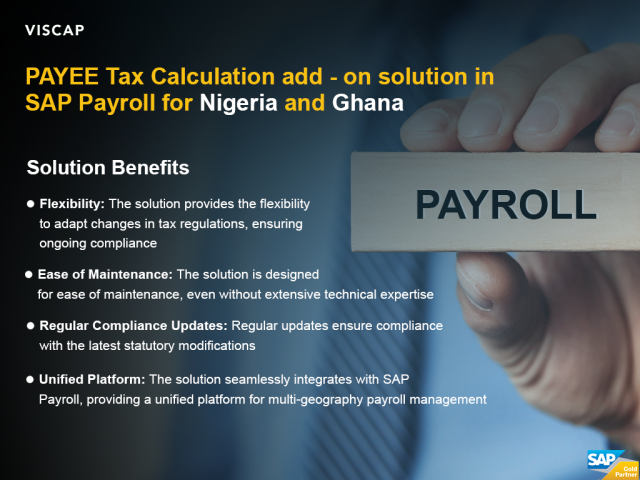
Overview
Organizations operating in Nigeria and Ghana often face challenges in accurately calculating PAYEE taxes for their employees due to the complexities of the respective tax structures. SAP Payroll, a widely used payroll management system, lacks standard functionalities for these countries, necessitating a tailored solution.
Benefits of the Proposed Add-on Solution
This custom SAP payroll solution offers several significant advantages:
- Flexibility: The solution provides the flexibility to adapt to changes in tax regulations, ensuring ongoing compliance.
- Ease of Maintenance: The solution is designed for ease of maintenance, even without extensive technical expertise.
- Regular Compliance Updates: Regular updates ensure compliance with the latest statutory modifications.
- Unified Platform: The solution seamlessly integrates with SAP Payroll, providing a unified platform for multi-geography payroll management.
Business requirement for calculation of PAYEE tax for Nigeria and Ghana
SAP Payroll has not provided any standard solution for tax calculation in Nigeria or Ghana. Therefore, we have created a custom payroll function called ZNTAX (PE02) to calculate PAYEE tax based on certain input from Employee Master and some custom tables.
The main requirement is to calculate the PAYEE tax as per the tax slabs and relief amounts defined by the respective governments for each country. The tax slabs and relief amounts may vary from year to year and need to be updated accordingly. The tax calculation should also consider the projected annual income of the employee based on the current month and the remaining months of the year.
Systems Involved
SAP S/4HANA HCM system
We have used SAP S/4HANA as the HRMS system to store and process the employee master data and payroll data. SAP S/4HANA is an HRMS solution that provides a comprehensive set of business processes and capabilities for various industries and regions.
Why is the SAP standard not appropriate or sufficient?
SAP Payroll does not have any standard solution for PAYEE tax calculation for Nigeria and Ghana. The standard payroll functions for tax calculation are country-specific and do not cover these countries. Therefore, we have to create a custom payroll function to meet the requirements.
Alternative Approaches Considered
We have considered two alternative approaches to creating the custom payroll function:
- Using a copy of an existing standard payroll function and modifying it to suit the requirement.
- Creating a new payroll function from scratch using the payroll function builder (PE02)
We have chosen the second approach as it gives us more flexibility and control over the logic and the parameters of the function. It also avoids any potential conflicts or errors that may arise from copying and modifying an existing standard function.
Expectation
The expectation from the custom payroll function is to calculate PAYEE tax as per the tax slabs and relief amounts for Nigeria and Ghana. The function should be easy to maintain and update regularly, year after year. The function should also be integrated with the SAP Payroll driver schema to process the payroll and calculate PAYEE tax for the respective months.
Solution Design
The solution design consists of the following components:
- Custom tables to store the tax slabs, wage types, and relief amounts for each country
- Custom payroll function ZNTAX to calculate payroll tax using the custom tables and the input table (payroll).
- SAP Payroll driver schema to invoke the custom payroll function and generate the output table (payroll).
Solution Design How to Build a Custom Function for Tax Calculation in SAP Payroll
We will explain how to design and implement a custom function for tax calculation in SAP Payroll. The custom function will use four tables and a program code to calculate the PAYEE tax for each month. The custom function will be inserted into the SAP Payroll driver schema to process the payroll.
The four tables are:
- ZT1: This table stores the tax slabs for each country and the applicable tax rates. The table has the following fields:
- Country code: The country code of the employee’s payroll area.
- Slab code: The code of the tax slab.
- Start date: the start date of the validity period of the tax slab.
- End date: the end date of the validity period of the tax slab.
- Slab range start: the lower limit of the taxable income for the tax slab.
- Slab range end: the upper limit of the taxable income for the tax slab
- Percentage: The tax rate for the tax slab.
- ZT2: This table stores the wage types that are used for tax calculation for each country. The table has the following fields:
- Country code: The country code of the employee’s payroll area.
- Start date: The start date of the validity period of the wage type
- End date: the end date of the validity period of the wage type.
- Wage type: The wage type that is used for tax calculation
- ZT3: This table stores the wage types that are used for tax relief for each country. The table has the following fields:
- Country code: The country code of the employee’s payroll area.
- Start date: The start date of the validity period of the wage type
- End date: the end date of the validity period of the wage type.
- Wage type: The wage type that is used for tax relief
- ZT4: This table stores the tax relief amount for each country. The table has the following fields:
- Country code: The country code of the employee’s payroll area.
- Start date: the start date of the validity period of the tax relief amount.
- End date: the end date of the validity period of the tax relief amount.
- Relief amount: the tax relief amount for the country.
Detailed Logic:
How to calculate the base value for tax calculation using table ZT2
- We will get the country code of the employee’s payroll area from table T001 by using the BURKS field from table PA0001.
- We will use the country code to filter the rows in table ZT2 by the payroll month.
- We will sum up the values of the wage types from the input table (payroll) that are used for tax calculation.
- We will project the sum by multiplying it by the number of remaining months in the current year, including the current month. This is the projected base value (BAS1).
Calculate the taxable income using tables ZT3 and ZT4.
- We will get the country code of the employee’s payroll area from table T001 by using the BURKS field from table PA0001.
- We will use the country code to filter the rows in table ZT3 by the payroll month.
- We will get the values of the wage types from the input table (payroll) that are used for tax relief and add them up.
- We will project the sum by multiplying it by the number of remaining months in the current year, including the current month. This is the projected relief value (REL1).
- We will get the relief amount from table ZT4 by country code. This is the relief amount (REL2).
- We will subtract the sum of REL1, REL2, and 20% of BAS1 from BAS1. This is the taxable income (Tax A1).
For NIGERIA,
calculate the tax for Nigeria using table ZT1.
- We will pass the taxable income (Taxa1) to table ZT1 according to the country code and the payroll month.
- We will find the tax slab that covers the taxable income by comparing the slab range start and end fields.
- We will get the slab code and the percentage fields for the matching tax slab and all the previous tax slabs.
- We will refer to the attached Excel file (ZT1-Logic) and calculate the annual tax (ATAX) using the slab code and the percentage fields.
- We will divide the annual tax by the number of remaining months in the current year, including the current month. This is the current month’s tax, and we will store it in wage type RT-3003.
- We will store the same value as the tax deducted so far in wage type RT-3004.
How to handle special cases for tax calculations
- If the taxable income (1BTX) is negative, the tax (RT-3003) is 1% of the total monthly income (BAS1).
- If the payroll area is A211 (Aba Pasta) or A511 (VFM), the tax (RT-3003) is 5% of the basic wage type (RT-1000).
- If the sum of the wage types for tax calculation is less than $30,000, no tax calculation is needed. To check this, we will do the following steps:
- We will get the country code of the employee’s payroll area from table T001 by using the BURKS field from table PA0001.
- We will use the country code to filter the rows in table ZT2 by the payroll month.
- We will get the values of the wage types from the input table (payroll) and add them up.
- If the sum is less than $30,000, we will stop the tax calculation process.
For GHANA,
calculate the base value for tax calculation using table ZT2.
- We will get the country code of the employee’s payroll area from table T001 by using the BURKS field from table PA0001.
- We will use the country code to filter the rows in table ZT2 by the payroll month.
- We will sum up the values of the wage types from the input table (payroll) that are used for tax calculation.
- We will project the sum by multiplying it by the number of remaining months in the current year, including the current month. This is the projected base value (BAS1).
calculate the tax using the chargeable income and the rate of tax.
- We will use the chargeable income (GHS) and the rate of tax (%) table to find the tax slab that applies to the projected base value (BAS1).
- We will calculate the tax for each tax slab by multiplying the difference between the slab range end and the slab range start by the percentage.
- We will add up the tax for each tax slab to get the annual tax.
- We will divide the annual tax by the number of remaining months in the current year, including the current month. This is the current month’s tax.
Important Topics
- Custom Payroll Function: ZNTAX (PE02) is the key component of the solution, responsible for calculating PAYEE taxes based on employee data and custom tables.
- Detailed Calculation Logic: The solution employs a comprehensive calculation logic that encompasses both Nigerian and Ghana tax regulations, ensuring accurate tax calculations.
- Flexibility and Adaptability: The solution’s custom design allows for easy adaptation to changes in tax regulations, ensuring ongoing compliance.
- Reduced Technical Expertise: The solution’s user-friendly design minimizes the need for technical expertise, making it accessible to a wider range of users.
Conclusion
This custom SAP payroll solution provides a robust and adaptable framework for calculating payroll taxes for employees in Nigeria and Ghana. It simplifies tax calculations, ensures compliance with local regulations, and minimizes the need for technical expertise.

